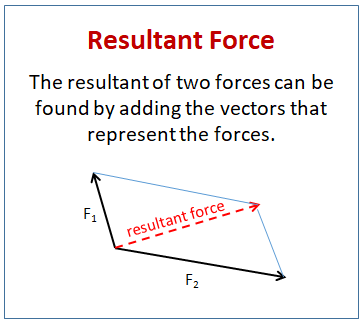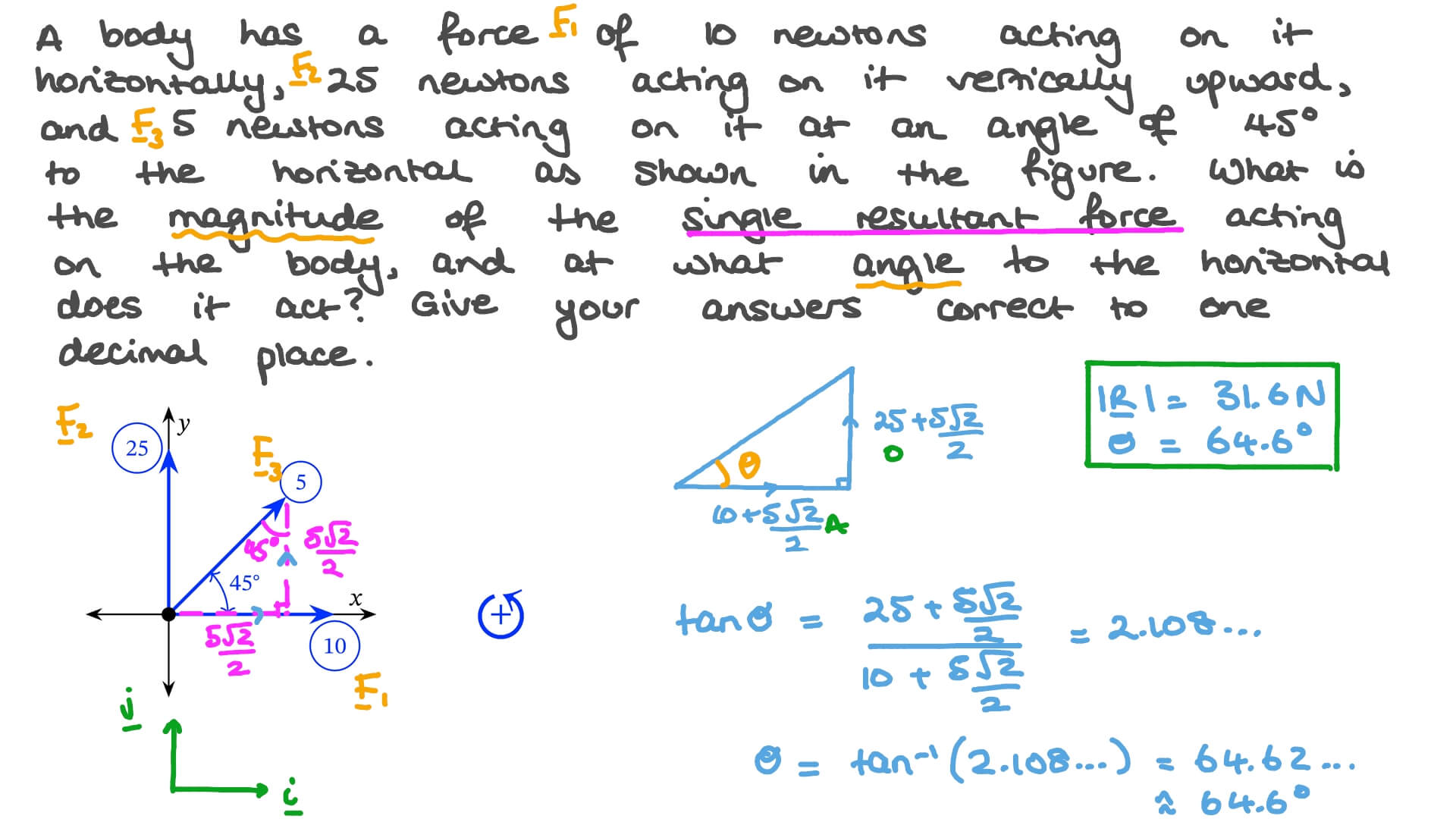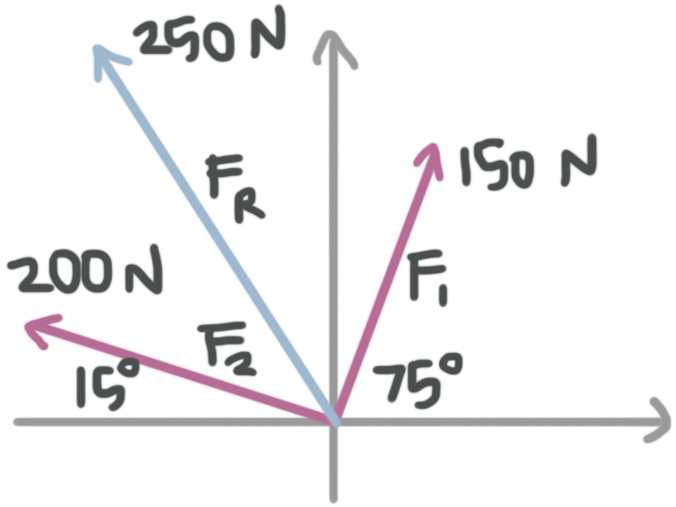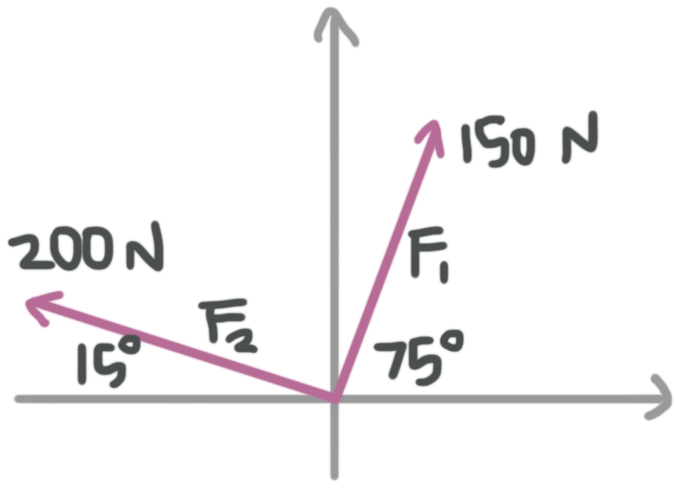Resultant Force I And J
For example If a boat has. EXAMPLE continued Summing up all the i and j components respectively we get FR 0 3182 360 i 300 3182 480 j N 4180 i 1098 j N x y FR.

Resultant Force And Coloumb S Law Of Electric Force Problems And Solutions Iit Jee And Neet Physics
Also when the object is at rest position or traveling with the same velocity then the resultant force has to be zero.

Resultant force i and j. Often however we know the forces that act on an object and we need. Taking components of forces can be used to nd the resultant force more quickly. If you require less simply leave them blank.
Mechanics i j notation Guaranteeing university rejection since the year whenever this presentation will be focusing on the bits most likely causing university rejection By Stephen the Mechanical Master of i and j notation. OverrightarrowR overrightarrowF_1 overrightarrowF_2 overrightarrowF_3 The parallelogram law triangle rule and polygon rule are geometric methods to find the force resultant. If two vectors are added together the resultant is found by placing the vectors to be added end to end.
It is supported at the ends. If an object is in equilibrium the resultant force is zero and the total moment of all the forces is zero To solve problems - Draw a diagram showing all the forces - By taking moments about a point you can ignore the forces acting at that point d 0 - Resolve the forces horizontally vertically A uniform bridge across a steam is 5m long and has a mass of 100 kg. F1 17 cos 27i 17 sin 27jF2 9 cos.
To find the magnitude and angle of a resultant force we. We can draw the force resultant but we dont know precisely its magnitude and direction. For example if a box of 15 kg is subject to 5 forces which make it accelerate 20 ms 2 north-west then the resultant force is directed north-west and has the magnitude equal to 15 kg 20 ms 2 30 N.
However the effect of forces and systems of forces can be represented by vectors. When two or more forces act on an object the resultant force can be found by adding up the individual forces. If the weight of the box acting.
For example the. Its the sum of all forces and their directions. F 2 F 1 F F 1 Resultant In order to add two forces together the start of the second force needs to be moved to the end of the rst force with the resultant going from the start of the rst.
The basics you need to know to answer the hard stuff i is the horizontal component j is the vertical component i j. The magnitude r of the resultant vector is then the net acceleration and is given by latexr x2y2z205latex There is a particular module in the DATS software that takes a tri-axial group of signals three signals and generates the resultant magnitude as shown. We call a force that can replace two or more other forces and produce the same effect a resultant force.
Resultant force It has already been stated that forces cannot be seen so they cannot be drawn. How to calculate resultant force. Resultant forces - Higher.
As it can be seen here that all the forces are acting towards the same direction hence the resultant force should be the same for all the forces. 220 displays the cutting force wave at v 1500 mmin from which it can be described that F z was the highest cutting force in the three components. So the resultant force F can be expressed in F z.
For example two forces of magnitudes F1 F2 acting upon a particle have a resultant as shown. The Resultant force is defined as the total effective force acting on a body along with their directions. Resultant force Vector diagrams of forces.
You can find the magnitude with Pythagorean Theorem and the direction with arctan vertical horizontal. The magnitude and angle of the resultant force. Resultant Force MechanicsCalculating the resultant force will be required in your mecanics and physics exams.
Create vector equations for each of the given forces. If the vectors are given in unit vector form you simply add together the i j and k values. Ill show you how to do this for 2 forces.
Resolving Forces - i j notation The method to nd a resultant as used in leaet 15 Force as a Vector is generally slow and can be complicated. Where i j and k are unit vectors in the x y and z directions. The resultant is the sum of the vectors which can easily be done by adding the 2 i components and the 2 j components.
The resultant force F was defined as F F x 2 F y 2 F z 2 12 according to the experimental setup in Fig. The first step in solving for a resultant force is determining the forces and angles. Then you have two legs of a right triangle.
A resultant force is the single force which represents the vector sum of two or more forces. 221 shows the axial cutting force F z at v c 500 mmin and v. The components are often.
The calculator above can solve for up to 5 different forces and angles. Which indicates that the resultant force R has the same direction as a and has magnitude equal to the product m a. Find magnitude of the resultant force using the new vector equation and the distance formula.
EXAMPLE continued F1 0 i 300 j N F2 450 cos 45 i 450 sin 45 j N 3182 i 3182 j N F3 35 600 i 45 600 j N 360 i 480 j N. In two dimensions a force can be resolved into two mutually perpendicular components whose vector sum is equal to the given force. The resultant force can be determined also for three-dimensional force systems by using the polygon rule.
D x 2 x 1 2 y 2 y 1 2. A resultant force is also known as the net force acting on an object. A box on a table.
Solution The method employed is to resolveF1andF2into horizontal and vertical components and then addthese to obtain the components of the resultant. Add the vector equations together to get the vector equation of the resultant force.

Calculating Resultant Forces Vector Diagrams Graphs Work Done Calculations Equilibrium Parallelogram Of Forces Tension Vector Forces Gcse 9 1 Physics Igcse Revision Notes
Finding The Magnitude And Angle Of The Resultant Force Vector Krista King Math Online Math Tutor

Calculating Resultant Forces Vector Diagrams Graphs Work Done Calculations Equilibrium Parallelogram Of Forces Tension Vector Forces Gcse 9 1 Physics Igcse Revision Notes

Resultant Force Key Stage Wiki

Calculating Resultant Forces Vector Diagrams Graphs Work Done Calculations Equilibrium Parallelogram Of Forces Tension Vector Forces Gcse 9 1 Physics Igcse Revision Notes

The Resultant Of Two Forces Solutions Examples Videos Worksheets Games Activities

How To Find The Resultant Of Two Vectors Youtube

Finding The Resultant Force Given Three Forces Youtube

Three Forces Are Acting On A Particle As Shown In The Figure To Have The Resultant Force Only Along The Y Direction The Magnitude Of The Maximum Additional Force Needed Is Img Src Https D10lpgp6xz60nq Cloudfront Net Physics Images

Determine The Magnitude And Direction Of The Resultant Force Youtube
Finding The Magnitude And Angle Of The Resultant Force Vector Krista King Math Online Math Tutor

Finding The Magnitude And Angle Of The Resultant Force Vector Krista King Math Online Math Tutor

Calculating Resultant Forces Vector Diagrams Graphs Work Done Calculations Equilibrium Parallelogram Of Forces Tension Vector Forces Gcse 9 1 Physics Igcse Revision Notes

Question Video Finding The Magnitude And Direction Of The Resultant Force Of Three Forces Acting On A Body Nagwa

How To Find Resultant Force Two Forces Mechanics Examsolutions Youtube

Magnitude And Angle Of The Resultant Force Kristakingmath Youtube



Post a Comment for "Resultant Force I And J"